I love sea trout at night above all other types of fly fishing because in the dark all your sensors are on high alert in anticipation of a take.
It’s an amazing feeling when your line tightens and you hear…
the splash of a hooked fish before it tears off downriver.
Then, you have to battle the wild fish with little or no sight of it until it slips into the net.
I’ve introduced a few friends to fly fishing for sea trout at night and in every case when they catch their first sea trout…
You can see in their eyes they’re hooked for life.
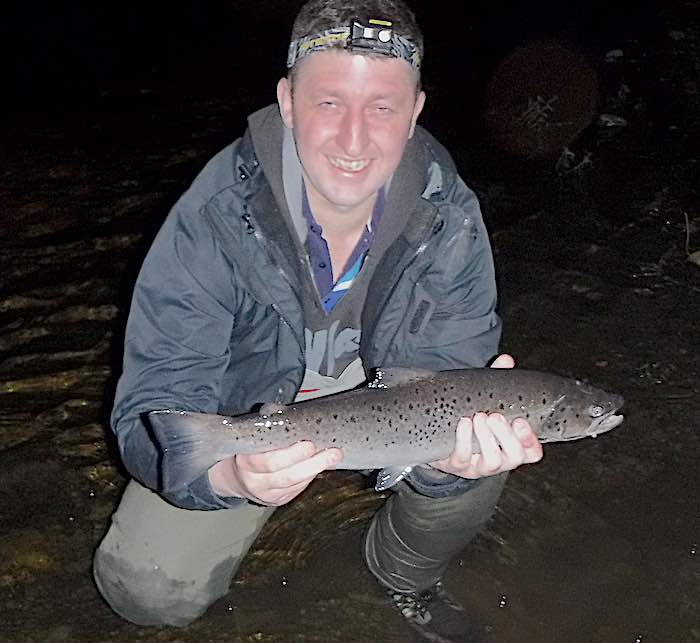
Welsh Dee sea trout fishing
The early run of large sea trout on the Welsh Dee starts in the middle of May and they are caught as far upriver as Corwen by early June. However, they are extremely hard to locate and catch on the fly.
Fortunately, the main run of sea trout begins around the middle of July and this is the best time to focus on sea trout fishing at night on the Welsh Dee.
Weather permitting, I will continue sea trout fly fishing until the end of August when my focus switches to salmon fishing. During this short 6/7-week period I try and get out sea trout fishing as often as possible.
Therefore, I wrote this post on how to catch sea trout at night to help a beginner get started and hopefully “HOOKED”.
First, let’s take a look at the fishing tackle you will need.
Tackle requirements for sea trout fishing at night
To start your quest for sea trout there is no need to buy a specialist sea trout fly rod, reel, and/or fly line.
I started sea trout fishing at night with a medium action 10ft 7wt rod, reel and floating line I had for rainbow trout fishing on reservoirs. Also, using a rod you regularly fish with during the day it will make casting at night easier to get the hang of. Even after 20 years, I still use my reservoir fly rod for sea trout fishing.
Sea trout fly rod basic requirements:
Any medium-tip (through) action fly rod between 9 to 10ft with an AFTM rating of between 6 and 8, will be OK to begin your sea trout fishing adventure. Avoid fast action rods because they won’t absorb the shock of a leaping sea trout; you will be devastated if you lose a big sea trout because your line breaks.

If you don’t possess such a rod then an inexpensive Shakespeare Sigma Supra 10ft 6 or 7wt is a good starting option; this was the rod I bought for my son to get him going.
Then, if night fishing is not for you can use it on the river for trout and grayling fishing.
Fly reel for sea trout fishing:
Chose a reel that matches the AFTM rating of the rod and has the capacity to take the fly line plus 100 yards of backing. If you need to buy a reel to get started, go for one that comes with a spare spool, which you can load with an intermediate (slow sinking) line.
Fly lines for sea trout fishing at night:
Most of the time a floating line will be the line choice for sea trout fishing because this line can be used to catch sea trout lying in less than 5ft of water. For ease of casting at night, I would go for a WF (weight-forward) line.
If asked to recommend one it would be Airflo Forty Plus Line, because that’s what I use. It’s easy to cast and reasonably priced.
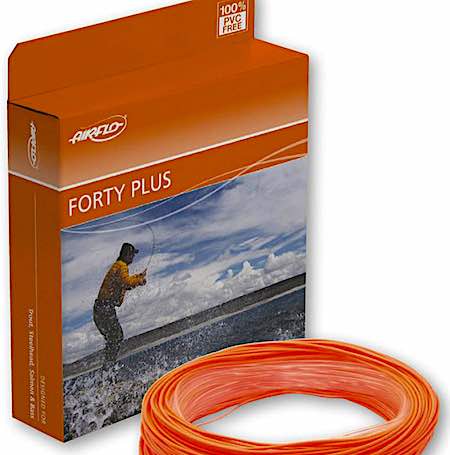
If you get “hooked” on sea trout fishing it would be useful to have a second line with you. My second line is a WF intermediate (slow sinking) line, which is useful when you need to fish a big fly closer to the riverbed.
Leaders & tippets for sea trout fishing at night:
If you are starting with just a floating line, then it would useful to have some polyleaders with you because these will allow you to fish the fly deeper (i.e. 5 to 7ft polyleaders: intermediate, medium, and fast sinking).
For fishing a single fly, I use a simple leader of 8 to 10ft of 8, 10, or 12lb of Maxima Ultragreen depending on the size of fly I’m fishing (i.e. 8lbs for fly sizes less than 8, fished at dusk and 10 or 12 lbs for small tube flies).
For large tubes, I use a much shorter leader (c.a. 4 – 5ft of 12lb Maxima) to help to cast these heavy flies.
When fishing a 2-fly cast I use about 10ft of 12lb Maxima and tie the dropper 4 ft down the leader from the fly line because it helps reduce line tangles.
Fly fishing accessories for sea trout fishing at night:
A robust folding landing net that can be attached to your jacket with an easy-release mechanism.
A good head torch, ideally with white and red-light sources and a spare pocket torch. I use the Nitecore NU25 headlamp for all my nightime fishing activities. (NB. don’t shine the torch on the water, always face away from the river when using it)
A jacket with multiple pockets to carry fly boxes, line etc
Finally, for safety a pair of DIY clear safety spectacles as eye protection and if you are wading a life jacket and wading stick.
Summary tackle for sea trout fishing at night
- 7 or 8wt 10 ft medium action fly rod – I currently use a Greys GR80 10ft 7wt fly rod
- Large arbour fly reel with a good drag
- Weight forward floating line & polyleaders
- 10 to 12 lbs copolymer leader
- A selection of sea trout flies (singles & tubes)
- Sea trout landing net
- Head torch with white & red lights – I use a small Nitecore NU25 fishing headlamp
- Hot refreshments
How to catch night-time sea trout
The best chance of catching sea trout in rivers is by fly fishing during the hours of darkness. However, it is possible to catch sea trout during daylight hours and at the end of this article, I have a link to another post on how to do just that.
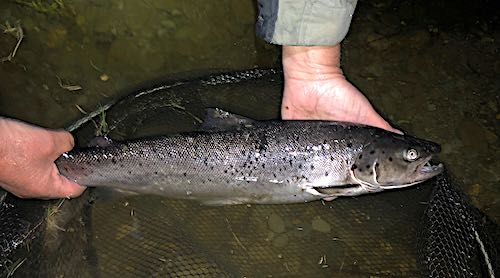
Most of my sea trout fishing at night has been done on the Welsh Dee but this approach can be applied to most UK rivers.
What are the best months to go sea trout fishing at night?
Generally, the best months for catching sea trout in the UK are June, July and August but peak runs vary from river to river. Therefore, it’s a good idea to study previous catch returns for the river you plan to fish to determine your best chances of success.
When you start sea trout fishing there is nothing worse than…
blanking night after night because there’s no sea trout to catch.
Trust me, I’ve learnt this the hard way!
For example, the best month(s) on the Welsh Dee at Llangollen are mid-July and August and July and August on the Conwy and River Ribble.
The next challenge to a successful night’s sea trout fishing is to be in the…
right place at the right time.
Sound simple but how do you do this…
Where are the best places to fish for sea trout at night?
Sea trout are not evenly distributed throughout the river but take up residence in areas that offer them sanctuary during daylight hours, without having to expend vital energy resources.
These areas are often the deeper sections of the pool with a steady flow and where the bank is undercut and/or lined with overhanging trees.
Under the full cover of darkness, sea trout will leave these daytime lies and move into areas of faster flow that are still smooth. For example, near the tails of pools or alongside gravel bars where the river narrows causing the flow increases.
In determining the best pools and places to a fish a river for sea trout I can’t stress enough the…
Value of local knowledge.
It will help you avoid many fruitless hours of fishing.
If the stretch for river belongs to a club then there will be members who are happy to point you in the right direction. For example, on the Welsh Dee at Llangollen just as me or check my fishing blog.
Also, search the internet for fishing forums and Facebook Groups and ask for advice there.
Even if you have obtained knowledge of where to fish, it’s still important to walk the river during daylight to check out likely holding pools and plan how to fish them when it’s dark.
On the Welsh Dee at Llangollen there are several pools that regularly produce sea trout at night, these include Dee Farm, Pipe Pool, Duncan’s Pool, Horseshoe Falls, Sea Trout Pool, and Mill Run to name just a few.
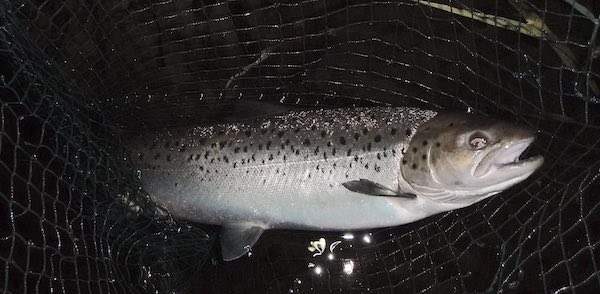
Best river weather conditions for sea trout fishing at night.
This is a tricky one but, generally, it’s best to go sea trout fishing when the river is running clear and close to its summer level.
On the Welsh Dee, I will always try and go fishing a few days after a summer spate when the river has cleared and is approaching its summer level. Mainly, because the spate encourages sea trout to move upriver and the new residents in the pools tend to be more active and easier to catch.
If the river is still carrying some colour, I will only fish for sea trout until dusk and save my energy for better conditions.
Ideal weather conditions for night-time sea trout fishing
Periods of settled weather conditions are usually the best for sea trout fishing. My preference is for a warm, dry, and cloudy night with a light wind (less than 10mph). Light rain is OK if the river level remains stable.
If the sky is clear, I will still venture out sea trout fishing if the moon is not too bright (i.e. less than ¼ of a moon) and the temperature stays in double figures.

Night sea trout fishing tactics
I don’t live local to any sea trout rivers and as such, I like to make the most of my evening’s sea trout fishing in Wales. Therefore, I often arrive a couple of hours before dark and walk the section of the river I’m going to fish looking for signs of where sea trout are lying.
At dusk, I will start fishing the fast water at the heads of pools with a floating line and a team of small wet flies on a 12ft 6lb leader. This can yield a few sea trout to 2 lbs in weight, which is great, sport on light tackle.
Examples of wet flies that catch Welsh Dee sea trout include:

- Hook: Kamasan B170 size 14 & 12
- Thread: Black UNI-Thread 8/0
- Body: Black seal fur substitute
- Rib: Uni Pearl Mylar (1/32)
- Legs: Black pheasant tail
- Hackle: Black (natural) hen

Silver Sedge
- Hook: Kamasan B170 size 12
- Thread: Black UNI-Thread 8/0
- Body: Silver tinsel & peacock herl
- Rib: Fine silver rib
- Hackle: Brown (natural) cock
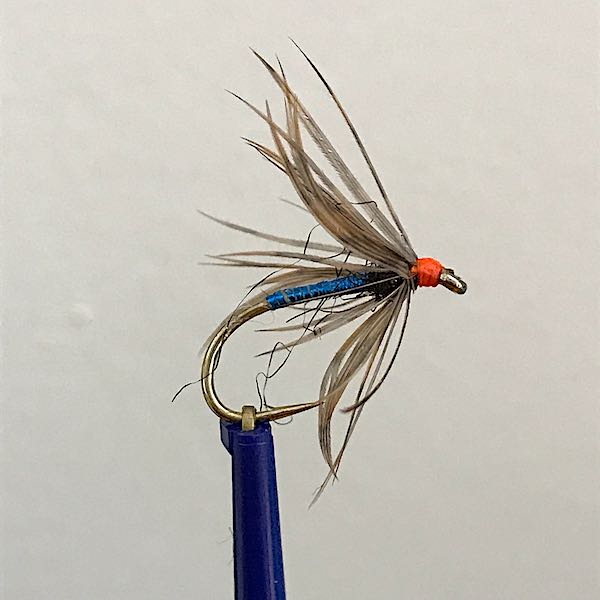
Grouse & Blue Bling Spider
- Hook – Kamasan B170 size 12 & 10
- Thread – fluoro-orange
- Body – holographic blue
- Thorax – purple Hends Spectra dubbing code 411
- Hackle – Grouse neck
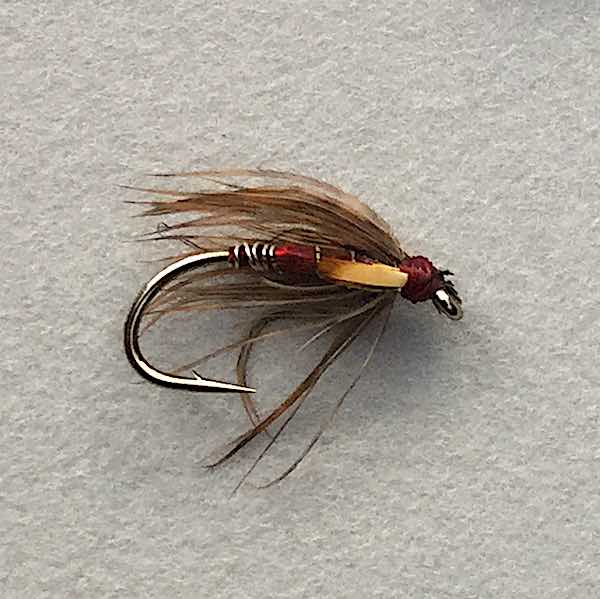
Red Bling Spider
- Hook – Kamasan B170 size 12 & 10
- Thread – red UNI 8/0
- Body – holographic red
- Rib – fine silver wire
- Hackle – Grouse neck
- Cheeks – split jungle cock
When it’s just possible to see the tree outlines on the far bank, I will begin to fish the pools which should be holding the larger sea trout. This is around 11 pm in July on the Welsh Dee.
How best to fish sea trout pools?
I’ve found the best results come from concentration on learning how to fish one or two pools thoroughly in a single sea trout fishing session.
If possible, try and fish the pool without wading to avoid disturbing sea trout that might be lying close in. When it’s not possible to fish from the bank wade the pool very carefully.
When wading at night SAFETY should be your NUMBER ONE priority.
My own personal rule is…
I never wade a pool at night unless I’ve waded it in daylight when the river is low at the start of each season.
I do this to check if anything has changed on the riverbed (e.g. gravel has moved, new obstacles have appeared during winter floods, etc).
Sea trout fishing at night with a floating line
On the Welsh Dee, as on many other rivers, sea trout are most active during the first two hours of darkness. Often, showing their location by jumping on warm evenings.
Under such conditions, it’s best, to begin fishing with a floating line tipped with 9ft of 10lb Maxima Ultragreen and initially a single sea trout fly (size 10 to 8). Examples of the flies I use on the Welsh Dee for sea trout fishing at night include:
Night-time Sea trout fly patterns:
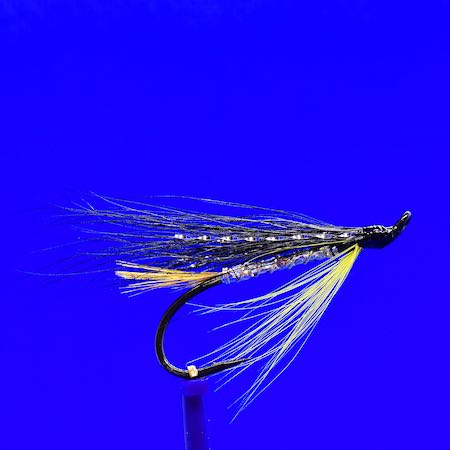
- Hook – # 10 to 6
- Thread – Black UNI 8/0
- Tag. – Pheasant tippet
- Body – Silver tinsel
- Rib – Fine silver wire
- Wing – Black Squirrel & silver flash
- Hackle. – Yellow cock

Black & Orange Dovey
- Hook – # 10 to 6
- Thread – Black UNI 8/0
- Tag. – Orange goose
- Body – Black floss
- Rib – Oval silver tinsel
- Wing – Black Squirrel
- Hackle. – Orange cock
- Cheeks – jungle cock
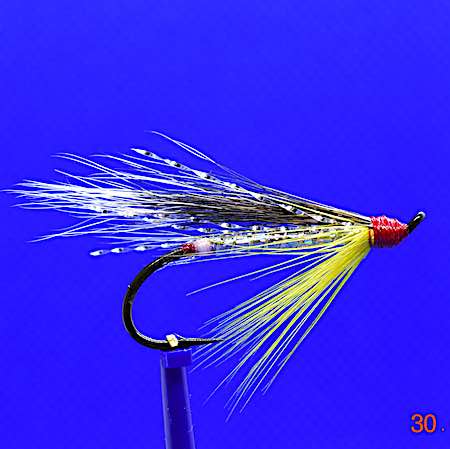
Silver Squirrel
- Hook – # 10 to 6
- Thread – Red UNI 8/0
- Tag. – Luminescent white floss
- Body – Silver tinsel
- Rib – Fine silver wire
- Wing – Squirrel tail & silver flash
- Hackle. – Yellow cock
If fishing the above single flies doesn’t produce any takes, switch to a larger fly on 9ft of 12lb Maxima (ca. 50 to 75mm tube fly or intruder pattern). Usually, it is not long (ca. 20min) before you will have a take if this switch is going to work.
The tube flies I use for sea trout fishing at night include:
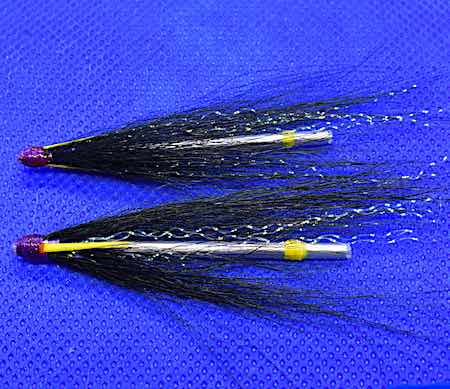
Black & Silver Al-tubes
- Tube – Aluminum 25 to 75mm
- Thread – Purple UNI 8/0
- Tag. – Fluorescent yellow floss
- Body – Bare tube
- Wing – Squirrel tail & pearl flash
- Cheeks – Yellow goose biot
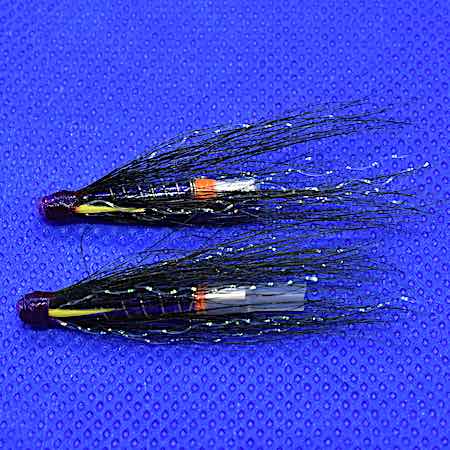
Ice-blue Wizard-hats
- Tube – Aluminum 25 to 75mm
- Thread – Purple UNI 8/0
- Tag. – Fluorescent orange floss
- Body – Black floss covered with ice-blue Mylar
- Wing – Squirrel tail & 2 strands of pearl flash
- Cheeks – Yellow goose biot
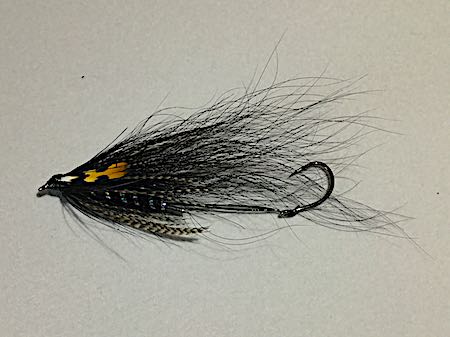
Black & Silver Stinger
- Tube – 35mm intruder shank
- Hook. – #8 Nordic on intruder wire
- Thread – Black UNI 8/0
- Body – Black floss
- Wing – Artic fox tail
- Hackle – Teal and black hen
- Cheeks – Jungle cock (optional)
How to fish a pool at night for sea trout?
Begin fishing the chosen section of the pool by casting as close to the far bank as possible, to fix your cast length. If there are trees on the far bank, I try to get the fly in between the trees because the bigger fish are often lying under their cover.
It’s essential to experiment with different casting angles and speed of retrieve until you find the combination that entices the sea trout to take your fly.
Recently, I was fishing a pool on the River Conway with a friend who was fishing a few metres behind me.
We were fishing almost the same setup and a very slow retrieve; however, he was getting takes and landing sea trout while I wasn’t.
The only difference between our approaches was Tim was casting directly across the river, while I was casting across and across and down at a 45o angle.
I changed to casting directly across the river and almost immediately…
BINGO – a beautiful sea trout snatched my fly.
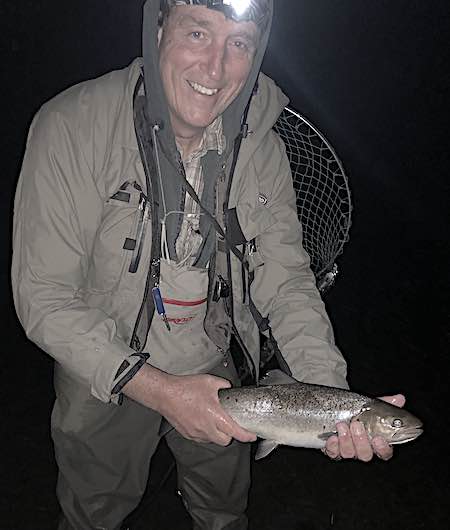
At every step down through the pool, I normally cast across and down at a 45o angle and make a slow retrieve. Then repeat the cast and retrieve it at a faster pace.
Then, repeat this process by casting directly across to the far bank.
In following the above process, you’ll be fishing the fly at different depths and this will allow you to determine which approach is successful.
If you feel any knock or pull on the fly, immediately make a line strike, and if this connects with a fish, quickly lift the rod. The advantage of the line trike over a rod strike is that if nothing connects you can continue to fish the fly through the pool and maybe get a second take.
When sea trout are just nipping the end of the fly then switching to fishing a smaller fly can be a successful approach.
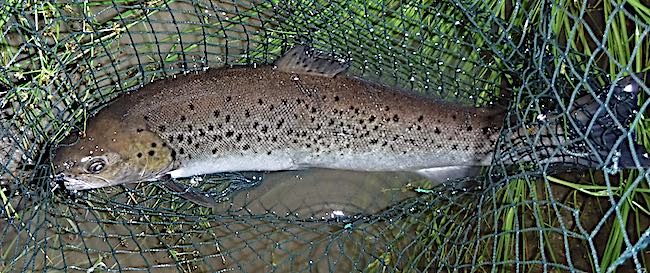
After fishing through the pool without a take, it’s best to change the approach. I often switch to fishing a surface (Wake) lune on a floating line for my next run through the pool.
The surface lure I tie and use on the Welsh Dee and other rivers is a great pattern designed by Stephan Jones:
If a surface lure fails to stimulate any interest a switch to fishing deeper with an intermediate or sink-tip line and experimenting with the fly size is usually the next move.
Sea trout fishing with a sinking line
There are a number of scenarios when it’s better to fish for sea trout with a sinking line:
- fishing a floating line hasn’t produced any takes,
- after the initial of hours of darkness takes have dried up,
- sea trout are lying in the deep sections of the pool, i.e. greater than 5ft.
Again, it’s important to fish the pool systematically with the sinking line, by varying the casting angle and speed of retrieve, as described for fishing a floating line.
In deep pools, there’s hardly any light penetrating the depths and it is usually best to fish large flies (75 mm+ in length) very slowly. It’s also worth trying a fly that causes some disturbance to alert sea trout to its presence.
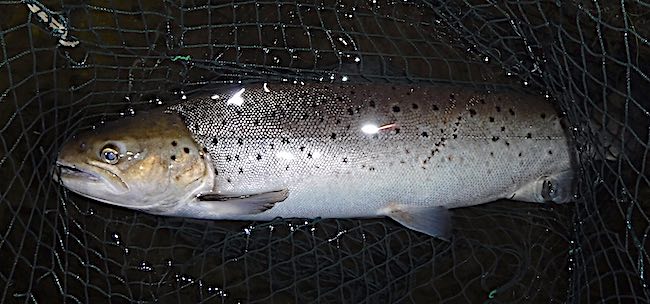
Hopefully, after trying all of the above you will have managed to hook and land a sea trout. If not it will be time to move on to the next pool to repeat the process or head off home.
A systematic approach to sea trout fishing at night teaches you how best to fish each pool and enables you to build a knowledge base of which approaches work best.
If you are interested in sea trout fishing at night on the Welsh Dee there is some excellent day ticket water at Llangollen
Also, the following post has further information on sea trout flies and sea trout fishing trips to the Welsh Dee
- Sea trout flies: 9 great patterns to use on the Welsh Dee
- Sea trout fishing in 2022 on the Dee
- Sea trout fishing in North Wales
Finally, If don’t like the idea of sea trout fishing at night, I have another post on how to catch sea trout during daylight hours that should interest you.
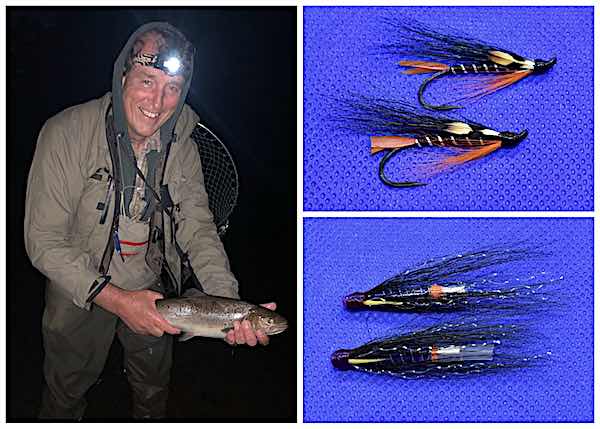
I just wanted to say a quick thank you for producing such a useful and informative website, you inspired me to make the effort to get over to the Dee. Like you, I’m something of a sea trout nut – I became addicted to the night life while living in Devon and having since moved to the East Midlands I’ve had some serious withdrawal symptoms. Thanks to your extremely useful guides I caught my first couple of Dee sea trout last weekend and I wanted to give you the credit you deserve for providing the assist.
Whereabouts in the East Mids are you James? I live nr Derby and also have sea trout urgings! The Welsh Dee I think is our closest river for them or would happily team up if you wanted to? Best Charles
Hi James,
Great to hear the post inspired you and you’ve caught some Welsh Dee silver.
Cheers, Andrew
Just found your website what a treasure trove of useful and interesting information thank you!
Hi George,
Great to hear you have found my fishing website and that you’ve found some useful info on it.
Cheers, Andrew
Pretty spot on information Andrew, vert good article again. The only difference for me when sea trout fishing is that I use a Hardy Demon 9’6” #7 with a Abu Garcia 710 automatic ( I know it’s a bit old fashioned , but I like it) loaded with a WF7 line. I tend to only use 2 flies, gold head hares ear on point and silver and grey hackled emerger about 3 feet higher. My usual haunts are the wires pool and top of the chain pool at Corwen. Have you tried the Wenning at Hornby? I know you fish PAAS water.
Hi Peter,
It’s good to hear you liked the article and about your approach to sea trout fishing. I’ve not fished any of the Corwen beats for sea trout at night but hope to give them a go this year. I know the Chain pool but where is the Wires pool?
I’ve fished the Wenning for the first time last year but only caught a couple of sea trout around the 1lb mark in July. Had my first outing this year on Friday night but just managed a very nice 2lb brown trout, which until it was netted I was sure it was gonna be a sea trout the way it behaved.
Have you fished the Wenning?
Cheers, Andrew
Very useful and interesting particularly the part about casting straight across as my last trip, a few weeks back, I was always casting at an angle and got no takers. Thanks.
Hi Andrew,
Great to hear the article was helpful.
Cheers, Andrew
Thank you for your excellent advice and lucid article, for anyone who is starting their sea trout journey, this article is very good.
My local river being, the beautiful Border – Esk, quite a wonderful sea trout river!
Also, thanks for sharing your sea trout fly images.
Hi Bryan,
I fished the Border Esk for salmon a couple of times in 2021. Saw a few salmon jump but didn’t hook any. I was going to fish at night for sea trout but never managed to but will give it a go in 2022. My son fished the Esk a couple of times and hooked a couple of sea trout but they threw the hook.
Great to hear you enjoyed the post.
Cheers, Andrew
Hi Andrew, I have booked the Low Moat on the Border Esk, 30/06/22. There may be two rods left, come and join us. It is quite a good time, subject to conditions!
Hi Bryan,
Thanks for letting me know. I’ve booked one of the slots so hopefully see you there on the 30/6.
Cheers, Andrew
As usual, first class, simple to understand advice. I’m keen to get better acquainted with sea trout and this is a great start. Thank you Andrew.
Hi Charles,
Pleased you enjoyed the article and I hope you manage to catch some sea trout this season.
Cheers, Andrew
Thanks Andrew, really useful, just need some rain in the Ribble now, it’s as low as I’ve ever seen it!
Hi Nick,
Great to hear you enjoyed it. Rain is definitely needed but not in sight.
Andrew
An excellent article that really gets the key points across. First, Narrow your pools down to no more than two, not necessary or advisable to be trekking along km of riverside in the dark. Get to know these pools in all conditions. Second, get systematic, casting angle, 45/90 degrees and retrieve rates, fast and slow figure of eights maintains direct contact with flies. I loved the tip on the strip strike too, very useful to keep the fly in the zone rather than lifting to set. Great article and if night fishing not for you, check out the article for Day Time Fishing.
Hi Mark,
Pleased to hear you enjoyed the article and that it has given you some ideas to improve your ST fishing.
Tight lines, Andrew
Many thanks for the really informative posting. Ive not fished for sea trout before but this is very inspirational.
Hi Bob,
Pleased to hear you enjoyed the post and found it informative. If you give sea trout fishing a go it would be great to hear how you get on.
Tight lines, Andrew